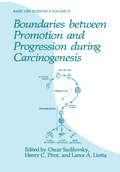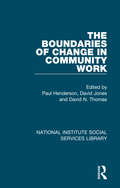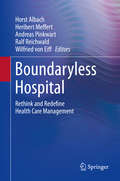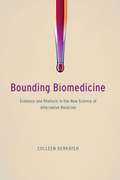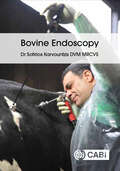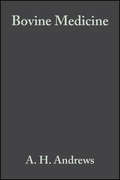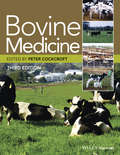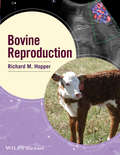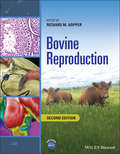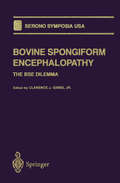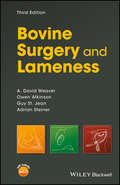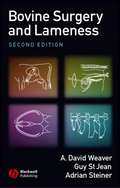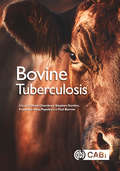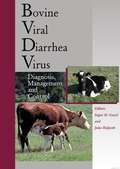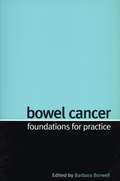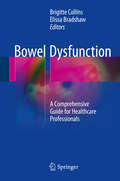- Table View
- List View
Boundaries between Promotion and Progression during Carcinogenesis (Basic Life Sciences #57)
by Oscar Sudilovsky Henry C. Pitot L. A. LiottaThe pUrpOSE! of this conference was not to define the two areas that are being bound, which might be a well nigh impossible proposition. Rather, its focus was to concentrate on the mechanistic similarities between promotion and progression. Are the areas involved within the boundaries a continuum? Are these two simultaneous processes? Or are some of the affected cells in the stage of promotion when at the same time others have undergone irreversi ble changes tha. t position them in the stage of progression? Or are these two stages the same thing, but called by different names? To explore such concepts we assembled investigators with various back grounds and asked them to specifically address these and other questions about "The Boundaries", within the context of the session to which they con tributed. The conference lasted two and a half days, from Wednesday to Friday. There were at least four speakers per session with morning and after noon sessions each day, except on Friday when the meeting ended at noon. The first day, each speaker had 25 minutes to present a position, followed by five minutes of discussion. At the end of the session there were 40 or 50 minutes of exchange on all the issues examined. For the remaining days, there were 25 minutes of presentation and 15 minutes of discussion.
The Boundaries of Change in Community Work (National Institute Social Services Library)
by Paul Henderson David Jones David N. ThomasSince the late 1960s, community work had emerged in its own right as an occupation with an increasingly important contribution to make both to ways of thinking within the field of social policy, and to day-to-day social work practice and the resolution of pressing community issues. Its practitioners had grown in numbers and experience, while community work ideas and methods continued to influence developments in a variety of other ‘neighbouring’ occupations. Originally published in 1980, the editors of this NISW collection suggest that if community workers are to remain effective, then they must stay on the boundaries of the agencies that employ them and of the groups with whom they work. This theme of the ‘boundary nature’ of community work is examined in detail in the Introduction and is subsequently taken up by the other contributors to the book. This title is organised under three main headings – a survey section on the history, philosophy and theories of community work in the United Kingdom; a series of case studies that suggest the diversity of the interests of community work; and an analysis of the growth of community work as an occupation and the spread of its influence through related professions and disciplines. This mix of theory, practice and analysis made the book of special importance both to practising community workers and to community work teachers and students at the time. In addition, the book would have been of direct interest to community oriented administrators, professionals, teachers and students in other human service fields such as health, education, housing, planning and the personal social services, as well as to elected members and administrators in central and local government more generally. It will now be welcomed by anyone who seeks a critical account of the historical activities of community work, written by experienced practitioners and teachers.
The Boundaries of Change in Community Work (National Institute Social Services Library)
by Paul Henderson, David Jones and David N. ThomasSince the late 1960s, community work had emerged in its own right as an occupation with an increasingly important contribution to make both to ways of thinking within the field of social policy, and to day-to-day social work practice and the resolution of pressing community issues. Its practitioners had grown in numbers and experience, while community work ideas and methods continued to influence developments in a variety of other ‘neighbouring’ occupations. Originally published in 1980, the editors of this NISW collection suggest that if community workers are to remain effective, then they must stay on the boundaries of the agencies that employ them and of the groups with whom they work. This theme of the ‘boundary nature’ of community work is examined in detail in the Introduction and is subsequently taken up by the other contributors to the book. This title is organised under three main headings – a survey section on the history, philosophy and theories of community work in the United Kingdom; a series of case studies that suggest the diversity of the interests of community work; and an analysis of the growth of community work as an occupation and the spread of its influence through related professions and disciplines. This mix of theory, practice and analysis made the book of special importance both to practising community workers and to community work teachers and students at the time. In addition, the book would have been of direct interest to community oriented administrators, professionals, teachers and students in other human service fields such as health, education, housing, planning and the personal social services, as well as to elected members and administrators in central and local government more generally. It will now be welcomed by anyone who seeks a critical account of the historical activities of community work, written by experienced practitioners and teachers.
Boundaryless Hospital: Rethink and Redefine Health Care Management
by Horst Albach Heribert Meffert Andreas Pinkwart Ralf Reichwald Wilfried Von EiffThis book discusses current health care challenges and new strategies for innovative solutions in this area from an interdisciplinary perspective of health care management, business economics, and medicine. It presents the idea of a “boundaryless hospital”, a conceptual model of a patient-centric, value-based health network that overcomes typical sectorial, organizational, and geographical boundaries and offers greater efficiency and better quality outcomes for patients.Effective health care for a growing and aging population is a major challenge for economies all over the world. New breakthroughs in medical technology and pharmaceuticals as well as digitization provide scope for more efficiency and for a better quality of health care. Novel organization forms and management concepts are key for coping with the increasing cost pressure observed in most health care systems. The contributions in this volume present innovative strategies for developing and implementing the concept of a boundaryless hospital. They highlight experiences from various countries and with different treatments. The book project was initiated and carried out by the Center for Advanced Studies in Management (CASiM), the interdisciplinary research center of HHL Leipzig Graduate School of Management for business administration in the 21st century.
Bounding Biomedicine: Evidence and Rhetoric in the New Science of Alternative Medicine
by Colleen DerkatchDuring the 1990s, an unprecedented number of Americans turned to complementary and alternative medicine (CAM), an umbrella term encompassing chiropractic, energy healing, herbal medicine, homeopathy, meditation, naturopathy, and traditional Chinese medicine. By 1997, nearly half the US population was seeking CAM, spending at least $27 billion out of pocket. Bounding Biomedicine centers on this boundary-changing era, looking at how consumer demand shook the health care hierarchy. Drawing on scholarship in rhetoric and science and technology studies, the book examines how the medical profession scrambled to maintain its position of privilege and prestige, even as its foothold appeared to be crumbling. Colleen Derkatch analyzes CAM-themed medical journals and related discourse to illustrate how members of the medical establishment applied Western standards of evaluation and peer review to test health practices that did not fit easily (or at all) within standard frameworks of medical research. And she shows that, despite many practitioners’ efforts to eliminate the boundaries between “regular” and “alternative,” this research on CAM and the forms of communication that surrounded it ultimately ended up creating an even greater division between what counts as safe, effective health care and what does not. At a time when debates over treatment choices have flared up again, Bounding Biomedicine gives us a possible blueprint for understanding how the medical establishment will react to this new era of therapeutic change.
Bounding Biomedicine: Evidence and Rhetoric in the New Science of Alternative Medicine
by Colleen DerkatchDuring the 1990s, an unprecedented number of Americans turned to complementary and alternative medicine (CAM), an umbrella term encompassing chiropractic, energy healing, herbal medicine, homeopathy, meditation, naturopathy, and traditional Chinese medicine. By 1997, nearly half the US population was seeking CAM, spending at least $27 billion out of pocket. Bounding Biomedicine centers on this boundary-changing era, looking at how consumer demand shook the health care hierarchy. Drawing on scholarship in rhetoric and science and technology studies, the book examines how the medical profession scrambled to maintain its position of privilege and prestige, even as its foothold appeared to be crumbling. Colleen Derkatch analyzes CAM-themed medical journals and related discourse to illustrate how members of the medical establishment applied Western standards of evaluation and peer review to test health practices that did not fit easily (or at all) within standard frameworks of medical research. And she shows that, despite many practitioners’ efforts to eliminate the boundaries between “regular” and “alternative,” this research on CAM and the forms of communication that surrounded it ultimately ended up creating an even greater division between what counts as safe, effective health care and what does not. At a time when debates over treatment choices have flared up again, Bounding Biomedicine gives us a possible blueprint for understanding how the medical establishment will react to this new era of therapeutic change.
Bounding Biomedicine: Evidence and Rhetoric in the New Science of Alternative Medicine
by Colleen DerkatchDuring the 1990s, an unprecedented number of Americans turned to complementary and alternative medicine (CAM), an umbrella term encompassing chiropractic, energy healing, herbal medicine, homeopathy, meditation, naturopathy, and traditional Chinese medicine. By 1997, nearly half the US population was seeking CAM, spending at least $27 billion out of pocket. Bounding Biomedicine centers on this boundary-changing era, looking at how consumer demand shook the health care hierarchy. Drawing on scholarship in rhetoric and science and technology studies, the book examines how the medical profession scrambled to maintain its position of privilege and prestige, even as its foothold appeared to be crumbling. Colleen Derkatch analyzes CAM-themed medical journals and related discourse to illustrate how members of the medical establishment applied Western standards of evaluation and peer review to test health practices that did not fit easily (or at all) within standard frameworks of medical research. And she shows that, despite many practitioners’ efforts to eliminate the boundaries between “regular” and “alternative,” this research on CAM and the forms of communication that surrounded it ultimately ended up creating an even greater division between what counts as safe, effective health care and what does not. At a time when debates over treatment choices have flared up again, Bounding Biomedicine gives us a possible blueprint for understanding how the medical establishment will react to this new era of therapeutic change.
Bounding Biomedicine: Evidence and Rhetoric in the New Science of Alternative Medicine
by Colleen DerkatchDuring the 1990s, an unprecedented number of Americans turned to complementary and alternative medicine (CAM), an umbrella term encompassing chiropractic, energy healing, herbal medicine, homeopathy, meditation, naturopathy, and traditional Chinese medicine. By 1997, nearly half the US population was seeking CAM, spending at least $27 billion out of pocket. Bounding Biomedicine centers on this boundary-changing era, looking at how consumer demand shook the health care hierarchy. Drawing on scholarship in rhetoric and science and technology studies, the book examines how the medical profession scrambled to maintain its position of privilege and prestige, even as its foothold appeared to be crumbling. Colleen Derkatch analyzes CAM-themed medical journals and related discourse to illustrate how members of the medical establishment applied Western standards of evaluation and peer review to test health practices that did not fit easily (or at all) within standard frameworks of medical research. And she shows that, despite many practitioners’ efforts to eliminate the boundaries between “regular” and “alternative,” this research on CAM and the forms of communication that surrounded it ultimately ended up creating an even greater division between what counts as safe, effective health care and what does not. At a time when debates over treatment choices have flared up again, Bounding Biomedicine gives us a possible blueprint for understanding how the medical establishment will react to this new era of therapeutic change.
Bovine Endoscopy
by Dr Sotirios KarvountzisEndoscopic applications are recognised and well-established techniques in human surgery, where a variety of procedures are performed routinely. A less intrusive and labour demanding process than surgery, these procedures have great potential for use in veterinary medicine. They allow a quicker clinical recovery, minimal intrusion and risk of bacterial exposure, and a lower mortality than conventional surgical options. Beginning with an introduction to the topic and an overview of bovine anatomy, this book then discusses both mainstream and experimental applications of endoscopy in cattle. It covers: - Practical advice on preparing for the procedure and patient restraint; - Techniques including LDA corrections, RDA corrections, exploratory laparoscopy, exploratory thoracoscopy, theloscopy and umbilical hernia corrections; - Post-operative care to allow the animal to rejoin the herd at the next milking, whenever possible. Written in a practical and accessible style for veterinary practitioners and students, the book provides a thorough and complete introduction to the exciting new field of bovine endoscopy.
Bovine Medicine: Diseases and Husbandry of Cattle
by Anthony H. Andrews Roger W. Blowey Hugh Boyd Roger G. EddyBovine Medicine provides practical and comprehensive information on cattle disease and production and is a key reference for all large animal vets. Since the first edition was published in 1991 there have been significant improvements in disease control and management of cattle. Almost all parts of the book have been updated and completely rewritten. There are new chapters on surgery, embryo transfer, artificial insemination, ethno-veterinary medicine and biosecurity, and a new consolidating chapter on the interaction between the animal, environment, management and disease. The previous edition has sold all over the world, and as a result of this a greater emphasis has been placed on conditions and their treatment in areas other than temperate regions. A new section entitled "Global Variation in Cattle Practice" has been included with contributors discussing bovine medicine practice in their part of the world. All in all this is an outstanding resource for any practising vet and an excellent reference for veterinary students.
Bovine Medicine
by Peter CockcroftThoroughly updated to reflect recent changes in the industry, Bovine Medicine, 3rd Edition, offers practicing large animal veterinarians and veterinary students a comprehensive reference to core aspects of contemporary cattle health and husbandry. New edition of a classic text, featuring thoroughly rewritten text, with coverage shifted to the core aspects of everyday cattle practice Includes new focus on both applied skills and application of knowledge, along with many more full-colour illustrations than in previous editions Represents a toolkit of skills that will support the delivery of contemporary cattle practice Presents a seamless integration of information on husbandry, nutrition, and disease Written by a wide range of experts from around the world
Bovine Medicine
by Peter D. CockcroftThoroughly updated to reflect recent changes in the industry, Bovine Medicine, 3rd Edition, offers practicing large animal veterinarians and veterinary students a comprehensive reference to core aspects of contemporary cattle health and husbandry. New edition of a classic text, featuring thoroughly rewritten text, with coverage shifted to the core aspects of everyday cattle practice Includes new focus on both applied skills and application of knowledge, along with many more full-colour illustrations than in previous editions Represents a toolkit of skills that will support the delivery of contemporary cattle practice Presents a seamless integration of information on husbandry, nutrition, and disease Written by a wide range of experts from around the world
Bovine Reproduction
by Richard M. HopperBovine Reproduction is a comprehensive, current reference providing information on all aspects of reproduction in the bull and cow. Offering fundamental knowledge on evaluating and restoring fertility in the bovine patient, the book also places information in the context of herd health where appropriate for a truly global view of bovine theriogenology. Printed in full color throughout, the book includes 83 chapters and more than 550 images, making it the most exhaustive reference available on this topic. Each section covers anatomy and physiology, breeding management, and reproductive surgery, as well as obstetrics and pregnancy wastage in the cow. Bovine Reproduction is a welcome resource for bovine practitioners, theriogenologists, and animal scientists, as well as veterinary students and residents with an interest in the cow.
Bovine Reproduction
by Richard M. HopperBovine Reproduction is a comprehensive, current reference providing information on all aspects of reproduction in the bull and cow. Offering fundamental knowledge on evaluating and restoring fertility in the bovine patient, the book also places information in the context of herd health where appropriate for a truly global view of bovine theriogenology. Printed in full color throughout, the book includes 83 chapters and more than 550 images, making it the most exhaustive reference available on this topic. Each section covers anatomy and physiology, breeding management, and reproductive surgery, as well as obstetrics and pregnancy wastage in the cow. Bovine Reproduction is a welcome resource for bovine practitioners, theriogenologists, and animal scientists, as well as veterinary students and residents with an interest in the cow.
Bovine Reproduction
by Richard M. HopperBovine Reproduction A complete resource for practical, authoritative information on all aspects of bovine theriogenologyThe newly revised Second Edition of Bovine Reproduction delivers a comprehensive overview of all major issues in bovine reproduction. Written by leading experts in the subject, the book is an indispensable reference for any veterinarian dealing with bovine fertility. Bovine Reproduction is divided into sections on the bull, the cow, the neonate, and assisted reproduction techniques. New chapters cover new gene manipulation technologies, managing problem donors, lameness, and more. Outdated and redundant information from the First Edition has been removed and replaced by coverage of new diseases, technologies, procedures, techniques, and approaches to fertility problems. A new companion website provides images and tables from the book in PowerPoint format. In addition to more than 675 full-color images, readers will also benefit from: A thorough discussion of the anatomy and physiology of the bull, including the endocrine and exocrine function of bovine testes and the thermoregulation of the testes An exploration of breeding and health management of bulls, including the evaluation of breeding soundness and ultrasound examination of the reproductive tract An examination of the anatomy, physiology, and the breeding and health management of cows, including fetal programming, the reproductive tract microbiome, and a section on obstetrics and reproductive surgery A review of the management of both critical care of the neonate and effective colostrum assessment and provision An introduction to assisted and advanced reproductive technologies A practical and comprehensive reference, Bovine Reproduction is a must-have purchase for bovine practitioners, theriogenologists, animal scientists, veterinary students, and residents with an interest in cattle.
Bovine Reproduction
by Richard M. HopperBovine Reproduction A complete resource for practical, authoritative information on all aspects of bovine theriogenologyThe newly revised Second Edition of Bovine Reproduction delivers a comprehensive overview of all major issues in bovine reproduction. Written by leading experts in the subject, the book is an indispensable reference for any veterinarian dealing with bovine fertility. Bovine Reproduction is divided into sections on the bull, the cow, the neonate, and assisted reproduction techniques. New chapters cover new gene manipulation technologies, managing problem donors, lameness, and more. Outdated and redundant information from the First Edition has been removed and replaced by coverage of new diseases, technologies, procedures, techniques, and approaches to fertility problems. A new companion website provides images and tables from the book in PowerPoint format. In addition to more than 675 full-color images, readers will also benefit from: A thorough discussion of the anatomy and physiology of the bull, including the endocrine and exocrine function of bovine testes and the thermoregulation of the testes An exploration of breeding and health management of bulls, including the evaluation of breeding soundness and ultrasound examination of the reproductive tract An examination of the anatomy, physiology, and the breeding and health management of cows, including fetal programming, the reproductive tract microbiome, and a section on obstetrics and reproductive surgery A review of the management of both critical care of the neonate and effective colostrum assessment and provision An introduction to assisted and advanced reproductive technologies A practical and comprehensive reference, Bovine Reproduction is a must-have purchase for bovine practitioners, theriogenologists, animal scientists, veterinary students, and residents with an interest in cattle.
Bovine Spongiform Encephalopathy: The BSE Dilemma (Serono Symposia USA)
by Clarence J. GibbsThe very first international working discussion on slow infections of the nervous system was entitled "Slow, Latent, and Temperate Virus Infec tions" and was held at the National Institutes of Health (NIH) in December 1964. The primary impetus was the discovery and investigation of kuru in New Guinea by D. Carleton Gajdusek, M. D. This working discussion brought together investigators in human and veterinary medicine, virolo gists, microbiologists, and neuropathologists actively engaged in laboratory work with viruses that illustrated properties of latency, masking, slowness, or temperateness, with emphasis on subacute and chronic neurologic dis eases of unknown etiology. In the Preface to the monograph of published papers presented at the working discussion, Gajdusek and Gibbs wrote the following: After microbiology had given solution to the etiology of most acute infections of the central nervous system and after fungi and bacteria had been incriminated in impor tant chronic disorders of the nervous system such as torula and tuberculosis men ingitis, we have been left, in neurology, with a wide range of subacute and chronic affections of the central nervous systems of unknown etiology. Some of these diseases, still listed as idiopathic, are among the most prevalent afflictions of the central nervous system. Many others with familial patterns of occurrence do not yet have their basic pathogenesis or underlying metabolic defect elucidated, although we tend to think of them as genetically mediated.
Bovine Surgery and Lameness (Library Of Veterinary Practice Ser.)
by A. David Weaver Owen Atkinson Guy St. Jean Adrian SteinerThe revised and updated Third Edition of Bovine Surgery and Lameness offers veterinarians a concise text ideal for use in the field. Offers a fully revised edition of the popular and well-respected book on bovine surgery and lameness Presents a practical quick-reference guide ideal for the field veterinarian Covers both common surgical procedures and the latest information on combating lameness Written by an expert team of international authors Includes access to a companion website offering video clips
Bovine Surgery and Lameness
by A. David Weaver Owen Atkinson Guy St. Jean Adrian SteinerThe revised and updated Third Edition of Bovine Surgery and Lameness offers veterinarians a concise text ideal for use in the field. Offers a fully revised edition of the popular and well-respected book on bovine surgery and lameness Presents a practical quick-reference guide ideal for the field veterinarian Covers both common surgical procedures and the latest information on combating lameness Written by an expert team of international authors Includes access to a companion website offering video clips
Bovine Surgery and Lameness (Library of Veterinary Practice)
by A. David Weaver Guy St. Jean Adrian SteinerBovine surgery is both challenging and complicated. Not only does the surgeon have to decide whether surgery is economically justified, but surgery often has to be performed in a sub-optimal environment. Following on from the worldwide success of the first edition, this new edition continues to act as a step-by-step guide to standard surgical techniques. Now with two new authors from Switzerland and North America, both the text and illustrations have been considerably expanded. In addition, special attention is given to issues relating to peri-operative analgesia and animal welfare, food safety, and drug dosages. Maintains the popular concise and accessible format of the first edition – perfect for on-the-field work; Two additional authors, with world renowned expertise in bovine surgery and lameness; Detailed instruction on the basics of effective surgery – proper instrumentation, asepsis, effective anaesthesia and essential techniques; Much more information on lameness, as well as numerous new line drawings to aid instruction.
Bovine Surgery and Lameness
by A. David Weaver Guy St. Jean Adrian SteinerBovine surgery is both challenging and complicated. Not only does the surgeon have to decide whether surgery is economically justified, but surgery often has to be performed in a sub-optimal environment. Following on from the worldwide success of the first edition, this new edition continues to act as a step-by-step guide to standard surgical techniques. Now with two new authors from Switzerland and North America, both the text and illustrations have been considerably expanded. In addition, special attention is given to issues relating to peri-operative analgesia and animal welfare, food safety, and drug dosages. Maintains the popular concise and accessible format of the first edition – perfect for on-the-field work; Two additional authors, with world renowned expertise in bovine surgery and lameness; Detailed instruction on the basics of effective surgery – proper instrumentation, asepsis, effective anaesthesia and essential techniques; Much more information on lameness, as well as numerous new line drawings to aid instruction.
Bovine Tuberculosis
by A. Arunachalam H. A. Bahamonde L. Borrelli S. Briggs G. Caballé C. Carrasco S. X. Chang C. Concha S. K. Dhyani F. Dube C. Dupraz M. E. Fernández C. Figueroa V. Gargaglione H. E. Garrett M. A. Gold Professor Andrew Gordon J. Gyenge N. E. Hansen M. F. Hawke S. Jose P. D. Kemp R. L. Knowles B. M. Kumar N. Lamersdorf G. J. Lawson M. V. Lencinas C. E. Lloyd G. Martínez Pastur R. Moore B. Müller-Using P. Neira S. Ormaechea V. P. Papanastasis X. Peng P. L. Peri D. J. Pilbeam A. Rosati J. Ruiz-Mirazo V. Rusch M. Sarasola J. M. Schwenke V. Schwenke R. Soler N. B. Stolpe L. E. Tejera N. V. Thevathasan A.R. von Müller W. Wang T. Ward L. Zabek E. ZagalThis book is contemporary, topical and global in its approach, and provides an essential, comprehensive treatise on bovine tuberculosis and the bacterium that causes it, Mycobacterium bovis. Bovine tuberculosis remains a major cause of economic loss in cattle industries worldwide, exacerbated in some countries by the presence of a substantial wildlife reservoir. It is a major zoonosis, causing human infection through consumption of unpasteurised milk or by close contact with infected animals. Following a systematic approach, expert international authors cover epidemiology and the global situation; microbial virulence and pathogenesis; host responses to the pathogen; and diagnosis and control of the disease. Aimed at researchers and practising veterinarians, this book is essential for those needing comprehensive information on the pathogen and disease, and offers a summary of key information learned from human tuberculosis research. It will be useful to those studying the infection and for those responsible for controlling the disease.
Bovine Viral Diarrhea Virus: Diagnosis, Management,and Control
by Sagar M. Goyal Julia F. RidpathFor almost 60 years, continual research on the subject of Bovine Viral Diarrhea (BVD) has raised as many questions as that research has answered. This common disease continues to cause sickness, death, abortion and fetal anomalies despite the millions of vaccination doses used each year to prevent its spread. Written by international experts on the subject of the BVD virus, BVDV: Diagnosis, Management and Control includes the latest information on BVD and outlines methods of diagnosis, management and control. Researchers, academics, and large animal practitioners will find this book an invaluable and irreplaceable resource for understanding and controlling outbreaks of BVD.
Bowel Cancer
by Barbara BorwellColorectal cancer is one of the most common killers of the 21st century. Bowel Cancer will develop the reader's knowledge and skills in both theory and practice and will enable nurses to demonstrate a good understanding of the problems posed by bowel cancer. This increased awareness provides opportunities for nurses to develop startegies that further enhance the quality and effectiveness of patient care. Acknowledging the vital role of a good working relationship for those engaged in the different aspects of care, the book provides a comprehensive introduction to colorectal cancer for all health professionals. From evolution and treatment to patient and family-centred care, including consideration of an individual's social, spiritual and psychological needs, either in the hospital or the community setting, Bowel Cancer is an excellent overall guide for all healthcare professionals.
Bowel Dysfunction: A Comprehensive Guide for Healthcare Professionals
by Brigitte Collins Elissa BradshawThe editors aim to provide the definitive guide for healthcare professionals on functional disorders of the gastrointestinal tract and pelvic floor, and the treatments used within the current healthcare context. This book will help the reader to access and understand relevant information within a variety of clinical settings and scenarios. It will be relevant and useful to a variety of disciplines (e.g. Physicians, Nurses, Physiotherapists) who work within the field of gastrointestinal care. This book will be written by a team from the worlds’ most well established colorectal specialist hospital, presenting a definitive guide to care of the patient group.
